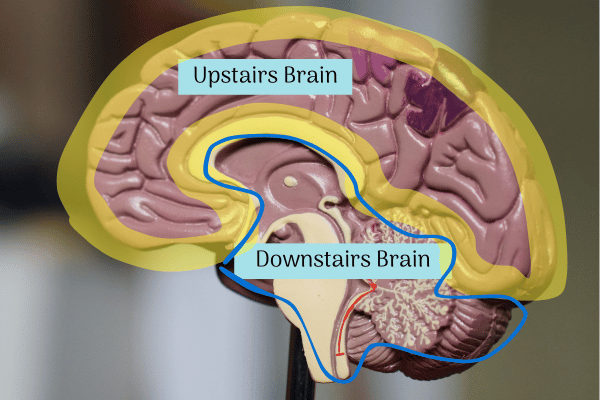3 Tips For Responding to BIG Emotions from Your PANDAS/PANS Child or Teen
A question I get asked a lot by PANDAS/PANS parents is, “How do I respond to the incredibly strong emotions from my PANDAS/PANS child or teen?”
The strong emotions might be anger, anxiety or sadness. The intensity of the emotions from your PANDAS/PANS child or teen can make you feel helpless and like you are swimming in the sea of overwhelm right alongside your child or teen.
Here are 3 steps you can take to address this issue:
"Downstairs Brain" outlined in blue, "Upstairs Brain" outlined in yellow.
1. Understand how your PANDAS/PANS child or teen's brain works 🧠
Because of brain inflammation, when our PANDAS/PANS kids or teens are having strong emotions, they are in what Dr. Dan Siegel, world-renowned child psychiatrist, calls, "the Downstairs Brain". (See image above, “Downstairs Brain” is outlined in blue.)
The downstairs brain is wired for survival.
The inflammation from PANDAS/PANS can cause the “Downstairs Brain” to disconnect more easily from the "Upstairs Brain". (“Upstairs Brain” is outlined in yellow).
The “Upstairs Brain” is where rational, logical thinking and problem-solving happens.
When the “Downstairs Brain” is activated, fight or flight symptoms occur such as anxiety or anger, and the “Downstairs Brain” cannot connect with the “Upstairs Brain” to calm itself with logical thinking or problem-solving.
When our PANDAS/PANS kids or teens are in their “Downstairs Brains”, we need to shift our responses as PANDAS/PANS parents. See next steps below.
2. Stay Calm (Easier Said Than Done, I know!) 😌
Since staying calm when your PANDAS/PANS child or teen’s big emotions is very hard to do, here are some tips:
Feel your feet on the floor (or whatever body part is holding you up). Press your feet firmly on the ground and notice the sensation. This can help anchor you and calm your body.
Slow your breathing. Try breathing in for 4 seconds, hold for 4 seconds, and out for 8 seconds. Repeat until you feel calmer.
Reset your posture. Check to see if you are holding tension in your jaw or shoulders. Purposefully relax your tight muscles and even shake your body a bit to help let go of tension. A quick reset of your posture sends calming signals to your brain.
3. Strive to Establish a Safe Connection (if possible) 👨❤️💋👨
Non-verbal connection is often the best first step if you sense that your PANDAS/PANS child or teen may be able to connect a bit.
Maintain a soft, neutral expression. Your facial expression can convey safety. Avoid showing fear, anger or frustration.
Use calm body language. Ensure your posture is non-confrontational. Avoid direct, head-on body orientation. Stand or sit slightly sideways, which is less confrontational and less likely to activate a “downstairs brain” response.
Respect personal space. If your PANDAS/PANS child or teen is highly activated, give them space. Avoid getting too close too quickly.
Use gentle eye contact. Offer a soft and gentle gaze, and occasionally look away. Some PANDAS/PANS kids or teens may find any eye contact threatening, so observe and adjust as needed.
Verbal connection is sometimes helpful for PANDAS/PANS kids or teens, but not always, so observe and adjust accordingly.
Use a soft, calm voice. Keep your voice low and slow to avoid triggering your child or teen.
Try simple reassurances such as, "you're safe", "I will respect what you need" can be helpful.
Offer choices, but if your child or teen becomes agitated, do not continue.
Do you need help for your PANDAS/PANS child or teen, or for yourself, as a PANDAS/PANS parent? I am available to help. Read here about how I work with PANDAS/PANS kids, teens and parents.
Reach out to me today for a free 15 minute consultation and feedback about your situation. Click here to contact me.

